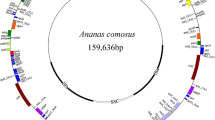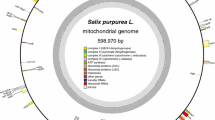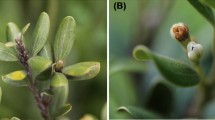Abstract
By screening sequence reads from the Salix suchowensis chloroplast (cp) genome that were generated by next-generation sequencing platforms, we assembled a complete circular pseudomolecule for the cp genome. This pseudomolecule is 155,508 bp long and has a typical quadripartite structure that contains two single copy regions, a large single copy region (LSC, 84,385 bp), and a small single copy region (SSC, 16,209 bp) separated by inverted repeat regions (IRs, 27,457 bp). Gene annotation revealed that the S. suchowensis cp genome encoded 119 unique genes, including four ribosome RNA genes, 30 transfer RNA genes, 82 protein-coding genes, and three pseudogenes. Analysis of the repetitive sequences revealed 31 tandem repeats, 16 forward repeats, and five palindromic repeats. In addition, a total of 148 perfect microsatellites, which were characterized as A/T dominant in nucleotide composition, were detected. Significant shifting of the IR/SSC boundaries was revealed by comparing this cp genome with those of other rosid plants. We also constructed phylogenetic trees to demonstrate the phylogenetic position of S. suchowensis in Rosidae based on 66 orthologous protein-coding genes present in the cp genomes of 32 species. Sequencing 30 amplicons based on the pseudomolecule for experimental verification revealed 99.88% accuracy for the S. suchowensis cp genome assembly. Therefore, we assembled a high-quality pseudomolecule of the S. suchowensis cp genome, which is a useful resource for facilitating development of this shrub willow into a more productive bioenergy crop.




Similar content being viewed by others
References
Arroyo-Garcia R, Ruiz-Garcia L, Bolling L, Ocete R, Lopez MA et al (2006) Multiple origins of cultivated grapevine (Vitis vinifera L. ssp. sativa) based on chloroplast DNA polymorphisms. Mol Ecol 15(12):3707–3714
Benson G (1999) Tandem repeats finder: a program to analyze dna sequences. Nucleic Acids Res 27(2):573–580
Cavalier-Smith T (2002) Chloroplast evolution: secondary symbiogenesis and multiple losses. Curr Biol Cb 12(2):62–64
Chen J, Hao Z, Xu H, Yang L, Liu G et al (2015) The complete chloroplast genome sequence of the relict woody plant Metasequoia glyptostroboides hu et cheng. Front Plant Sci 6:447
Dai X, Hu Q, Cai Q, Feng K, Ye N et al (2014) The willow genome and divergent evolution from poplar after the common genome duplication. Cell Res 24(10):1274–1277
Daniell H (2007) Transgene containment by maternal inheritance: effective or elusive? Proc Natl Acad Sci 104(17):6879–6880
Daniell H, Khan MS, Allison L (2002) Milestones in chloroplast genetic engineering: an environmentally friendly era in biotechnology. Trends Plant Sci 7(2):84–91
Drescher A, Ruf S, Calsa T, Carrer H, Bock R (2000) The two largest chloroplast genome-encoded open reading frames of higher plants are essential genes. Plant J 22(2):97–104
Ewing B, Hillier LD, Wendl MC, Green P (1998) Base-calling of automated sequencer traces using phred. i. accuracy assessment. Genome Res 8(3):175–185
Fang Z, Zhao S, Skvortsov AK (1999) Saliceae. In: Zheng-yi W, Raven PH (eds) Flora of China. Missouri Botanical Garden Press, St. Louis, pp 139–274
Goulding SE, Wolfe KH, Olmstead RG, Morden CW (1996) Ebb and flow of the chloroplast inverted repeat. Mol Gen Genet MGG 252(1–2):195–206
Huang CY, Ayliffe MA, Timmis JN (2003) Direct measurement of the transfer rate of chloroplast dna into the nucleus. Nature 422(6927):72–76
Kuang D, Wu H, Wang Y, Gao L, Zhang S et al (2011) Complete chloroplast genome sequence of Magnolia kwangsiensis (Magnoliaceae): implication for DNA barcoding and population genetics. Genome 54:663–673
Lalitha S (2000) Primer premier 5. Biotech Softw Internet Rep 1(6):270–272
Larkin MA, Blackshields G, Brown NP, Chenna RM, McGettigan PA et al (2007) Clustal w and clustal x version 2.0. Bioinformatics 23(21):2947–2948
Ma Q, Li S, Bi C, Hao Z, Sun C, Ning Y (2016) Complete chloroplast genome sequence of a major economic species, Ziziphus jujuba (Rhamnaceae). Curr Genet 63:1–13
Mcpherson H, Merwe MVD, Delaney SK, Edwards MA, Henry RJ et al (2013) Capturing chloroplast variation for molecular ecology studies: a simple next generation sequencing approach applied to a rainforest tree. BMC Ecol 13(1):53–65
Millen RS, Olmstead RG, Adams KL, Palmer JD, Lao NT et al (2001) Many parallel losses of infa from chloroplast DNA during angiosperm evolution with multiple independent transfers to the nucleus. Plant Cell 13(3):645–658
Neuhaus HE, Emes MJ (2000) Nonphotosynthetic metabolism in plastids. Annu Rev Plant Biol 51(4):111–140
Nock CJ, Baten A, King GJ (2014) Complete chloroplast genome of Macadamia integrifolia confirms the position of the gondwanan early-diverging eudicot family proteaceae. BMC Genom 15(Suppl 9):S13
Palmer JD, Jansen RK, Michaels HJ, Chase MW, Manhart JR (1988) Chloroplast DNA variation and plant phylogeny. Ann Mo Bot Gard 75(4):1180–1206
Pyke KA (1999) Plastid division and development. Plant Cell 11(4):549–556
Qian J, Song J, Gao H, Zhu Y, Xu J et al (2013) The complete chloroplast genome sequence of the medicinal plant Salvia miltiorrhiza. PLoS ONE 8(2):e57607
Raubeson LA, Jansen RK (2005) Chloroplast genomes of plants. In: Henry RJ (eds) Plant diversity and evolution: genotypic and phenotypic variation in higher plants. CABI Publishing, Cambridge, MA, pp 45–68
Reboud X, Zeyl C (1994) Organelle inheritance in plants. Heredity 72(2):132–140
Sanchezpuerta MV, Abbona CC (2014) The chloroplast genome of Hyoscyamus niger and a phylogenetic study of the tribe hyoscyameae (solanaceae). PLoS ONE 9(5):e98353
Sato S, Nakamura Y, Kaneko T, Asamizu E, Tabata S (1999) Complete structure of the chloroplast genome of Arabidopsis thaliana. DNA Res 6(5):283–290
Schattner P, Brooks AN, Lowe TM (2005) The tRNAscan-SE, snoscan and snoGPS web servers for the detection of tRNAs and snoRNAs. Nucleic Acids Res 33(suppl 2):W686–W689
Sherman-Broyles S, Bombarely A, Grimwood J, Schmutz J, Doyle J (2014) Complete plastome sequences from glycine syndetika and six additional perennial wild relatives of soybean. G3: genes Genomes. Genetics 4(10):2023–2033
Smart LB, Cameron KD (2008) Genetic improvement of Willow (Salix spp.) as a dedicated bioenergy crop. Genet Improv Bioenergy Crops 2:377–396
Stegemann S, Bock R (2006) Experimental reconstruction of functional gene transfer from the tobacco plastid genome to the nucleus. Plant Cell 18(11):2869–2878
Sugiura M (1995) The chloroplast genome. Essays Biochem 30(1):49–57
Tamura K, Stecher G, Peterson D, Filipski A, Kumar S (2013) Mega6: molecular evolutionary genetics analysis version 6.0. Mol Biol Evol 30(12):2725–2729
Timmis JN, Ayliffe MA, Huang CY, Martin W (2004) Endosymbiotic gene transfer: organelle genomes forge eukaryotic chromosomes. Nat Rev Genet 5(2):123–135
Treangen TJ, Sommer DD, Angly FE, Koren S, Pop M (2011) Next generation sequence assembly with AMOS. Curr Protoc Bioinform 33:11.8.1–11.8.18
Tuskan GA, DiFazio S, Jansson S, Bohlmann J, Grigoriev I et al (2006) The genome of black cottonwood, Populus trichocarpa (Torr. & Gray). Science 313(5793):1596–1604
Verma D, Daniell H (2007) Chloroplast vector systems for biotechnology applications. Plant Physiol 145(4):1129–1143
Vries JD, Sousa FL, Bölter B, Soll J, Gould SB (2015) YCF1: a green Tic? Plant Cell 27(7):1827–1833
Wang C, Fang CF, Zhao SD (1984) Salicaceae. Flora Reipublicae Pop Sin 20(2):79–403
Wang RJ, Cheng CL, Chang CC, Wu CL, Su TM, Chaw SM (2008) Dynamics and evolution of the inverted repeat-large single copy junctions in the chloroplast genomes of monocots. BMC Evol Biol 8(1):1
Wu Z (2015) The new completed genome of purple Willow (Salix purpurea) and conserved chloroplast genome structure of Salicaceae. J Nat Sci 1:e49
Wyman SK, Jansen RK, Boore JL (2004) Automatic annotation of organellar genomes with DOGMA. Bioinformatics 20(17):3252–3255
Yao X, Tang P, Li Z, Li D, Liu Y, Huang H (2015) The first complete chloroplast genome sequences in actinidiaceae: genome structure and comparative analysis. PLoS ONE 10(6):e0129347
Yap JYS, Rohner T, Greenfield A, Merwe MVD, Mcpherson H et al (2015) Complete chloroplast genome of the wollemi pine (Wollemia nobilis): structure and evolution. PLoS ONE 10(6):e0128126
Zhang G, Guo G, Hu X, Zhang Y, Li Q et al (2010) Deep RNA sequencing at single base-pair resolution reveals high complexity of the rice transcriptome. Genome Res 20(5):646–654
Author information
Authors and Affiliations
Corresponding author
Additional information
Project Funding: This work was supported by the Key Forestry Public Welfare Project (201304102), and the Natural Science Foundation of China (31400564 and 315005533). It was also enabled by the Innovative Research Team of the Educational Department of China and the PAPD (Priority Academic Program Development) program at Nanjing Forestry University.
The online version is available at http://www.springerlink.com
Corresponding Editor: Yu Lei.
Electronic supplementary material
Below is the link to the electronic supplementary material.
Rights and permissions
About this article
Cite this article
Sun, C., Li, J., Dai, X. et al. Analysis and characterization of the Salix suchowensis chloroplast genome. J. For. Res. 29, 1003–1011 (2018). https://doi.org/10.1007/s11676-017-0531-3
Received:
Accepted:
Published:
Issue Date:
DOI: https://doi.org/10.1007/s11676-017-0531-3




